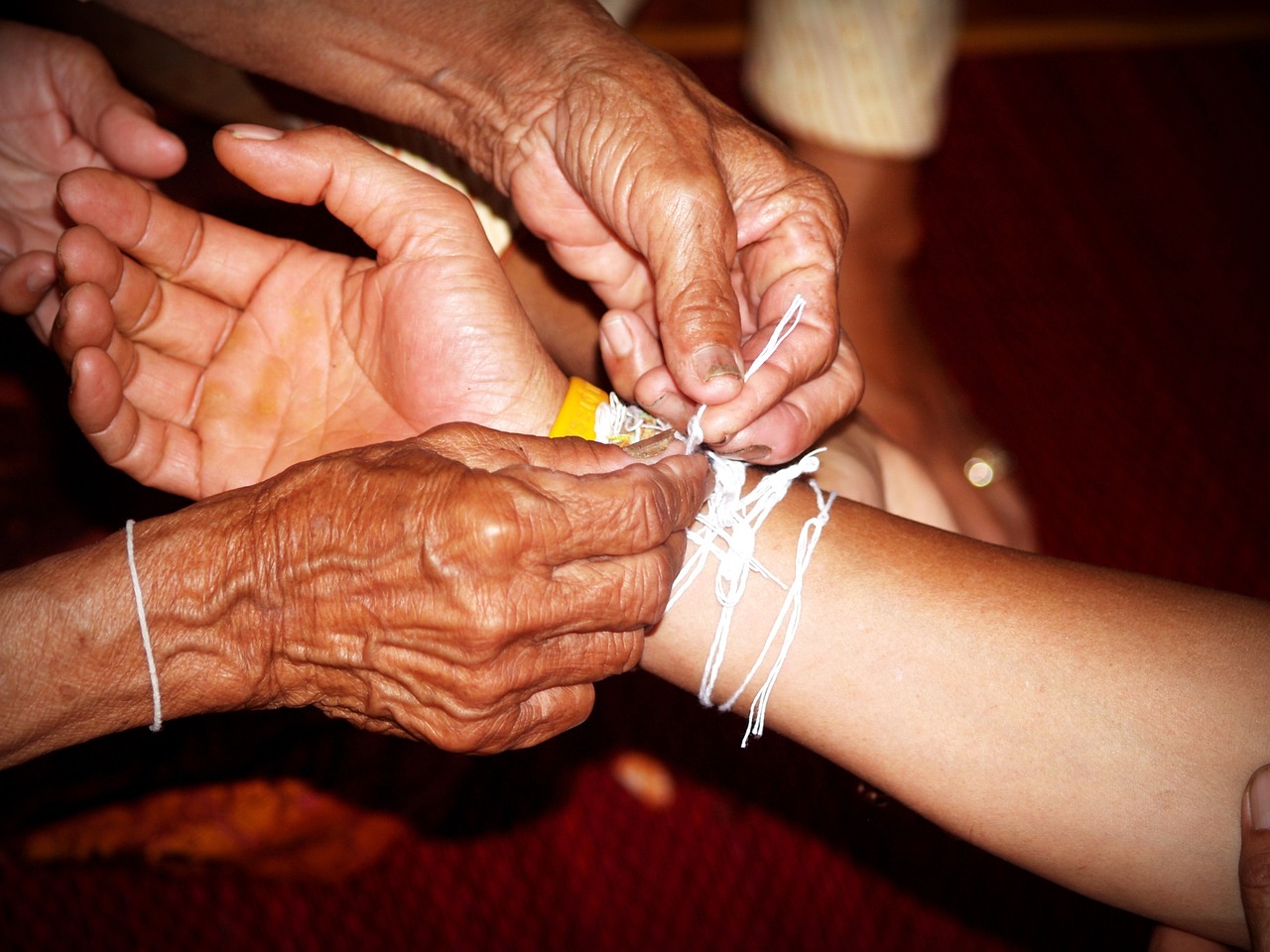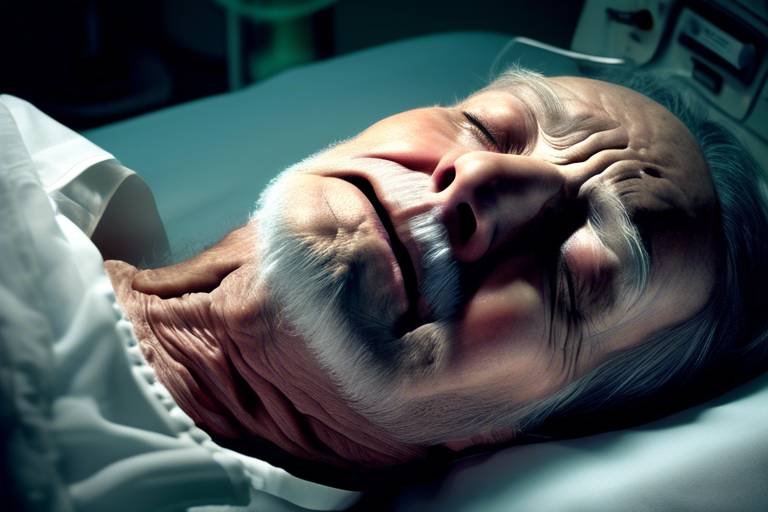What Can Comatose Patients Teach Us About Consciousness?
Have you ever wondered what it truly means to be conscious? It's a question that has puzzled philosophers, scientists, and curious minds for centuries. When we think of consciousness, we often picture vibrant interactions with the world around us—our thoughts, feelings, and perceptions. But what happens when a person enters a comatose state? Surprisingly, studying these patients can offer profound insights into the very nature of consciousness itself, challenging our assumptions and expanding our understanding of the human mind.
Comatose patients exist in a state that seems to blur the lines between awareness and unawareness, leading us to question: Is consciousness a binary state, or is it more of a spectrum? In this article, we will explore how examining comatose patients can illuminate the depths of consciousness, brain function, and awareness. By diving into the complexities of coma and its various forms, we can glean insights that might just redefine our understanding of what it means to be aware.
As we peel back the layers of this intricate topic, we will uncover the different types of coma, from the vegetative state to the minimally conscious state. Each type presents unique characteristics and implications for patient awareness, prompting us to reconsider how we define and recognize consciousness. We'll also take a closer look at the diagnostic tools used by medical professionals, such as EEG and functional MRI, which help us understand the brain's activity in these patients. These technologies are like windows into the mind, revealing hidden truths about cognitive states that may not be immediately apparent.
Moreover, we will highlight remarkable case studies that have emerged from the field, showcasing unexpected signs of consciousness in individuals who were once thought to be entirely unresponsive. These stories are not just fascinating; they challenge the traditional views of awareness and recovery, suggesting that there may be more to consciousness than we previously believed.
In addition to the scientific exploration, we will also delve into the human side of caring for comatose patients. The role of family is crucial in these situations, providing emotional support and making vital decisions regarding treatment options. We will discuss innovative communication techniques that can foster connections between families and patients, potentially leading to moments of responsiveness that can ignite hope in dire circumstances.
Finally, we will examine the ethical considerations that arise in the care of comatose patients. Questions about consent, quality of life, and end-of-life decisions are not just abstract concepts; they are real dilemmas faced by families and medical professionals alike. As we navigate these complex issues, we must also look toward the future. Emerging research in neuroscience holds promise for new therapeutic approaches that could enhance recovery and deepen our understanding of consciousness.
So, what can comatose patients teach us about consciousness? The answer is multifaceted and deeply enriching. By exploring the intersection of science, ethics, and human connection, we can gain a more nuanced perspective on what it means to be aware, even in the most challenging circumstances. Join us on this journey as we unravel the mysteries of consciousness through the lens of comatose patients.
- What is consciousness? Consciousness refers to the state of being aware of and able to think and perceive one's surroundings, thoughts, and feelings.
- What are the different types of coma? The main types include vegetative state, minimally conscious state, and coma itself, each with varying degrees of awareness.
- How is coma diagnosed? Diagnosis typically involves neurological assessments, imaging technologies like MRI, and EEG monitoring to evaluate brain activity.
- Can comatose patients hear or understand what is happening around them? Some studies suggest that patients in certain states may retain some level of awareness, but this varies greatly between individuals.
- What role do families play in the care of comatose patients? Families provide emotional support, make treatment decisions, and can utilize communication techniques to engage with their loved ones.

The Nature of Consciousness
When we think about consciousness, we often find ourselves diving into a vast ocean of philosophical debates and scientific inquiries. What does it truly mean to be aware? Is consciousness merely a byproduct of brain activity, or is it something more profound? These questions are not just academic; they have real implications, especially when we consider patients in comatose states. Understanding consciousness can help us make sense of the experiences—or lack thereof—of these individuals.
At its core, consciousness can be described as the state of being aware of and able to think about one’s own existence, thoughts, and surroundings. However, this definition barely scratches the surface. Philosophers like René Descartes famously stated, “I think, therefore I am,” suggesting that the very act of thinking is a hallmark of consciousness. On the other hand, scientists approach consciousness from a biological perspective, examining how brain functions correlate with conscious experiences. This duality raises intriguing questions: Can we measure consciousness? Is it possible for someone to be aware without showing any outward signs?
In the context of comatose patients, the exploration of consciousness becomes even more complex. Patients in a coma may exhibit varying levels of awareness, ranging from complete unresponsiveness to subtle signs of consciousness. This spectrum of awareness leads us to categorize consciousness into different states, such as the vegetative state and the minimally conscious state. Each of these categories presents unique characteristics that challenge our understanding of what it means to be “awake.”
To illustrate, let’s break down these states:
- Vegetative State: This condition is marked by the absence of awareness of self and the environment, yet patients may still exhibit sleep-wake cycles and reflexive responses.
- Minimally Conscious State: In this state, patients may show intermittent signs of awareness, such as following simple commands or responding to stimuli in a meaningful way.
These classifications are not just academic; they have profound implications for treatment and care. Understanding where a patient falls on this spectrum can guide families and medical professionals in making informed decisions about their care. It raises the question: How do we measure consciousness? And what tools do we have at our disposal to assess a comatose patient's state?
Modern neuroscience has equipped us with an array of tools to dive deeper into these questions. Techniques like electroencephalography (EEG) and functional MRI (fMRI) allow us to observe brain activity in real time, shedding light on the elusive nature of consciousness. For instance, EEG can detect electrical activity in the brain, revealing whether a patient is responding to stimuli even if they appear unresponsive. Similarly, fMRI can visualize brain regions that light up during specific tasks, suggesting that some patients might be more aware than previously thought.
In summary, the nature of consciousness is a multifaceted topic that blends philosophy, science, and ethics. As we continue to study comatose patients, we gain valuable insights into the depths of human awareness, challenging our preconceived notions and potentially reshaping our understanding of what it means to be conscious. The journey into the mind of a comatose patient is not just about medical diagnoses; it’s a profound exploration of the very essence of being.

When we hear the term coma, it often conjures up images of a person lying motionless, seemingly disconnected from the world around them. But what exactly does it mean to be in a coma? It's not just a single state; rather, there are various types of comatose conditions, each with its own nuances and implications for awareness. Understanding these differences is crucial, as it helps us navigate the complex landscape of consciousness and the human experience.
At its core, a coma is a state of prolonged unconsciousness. However, there are distinct categories that fall under this umbrella. The most common types include:
- Vegetative State (VS): In this condition, a patient may have sleep-wake cycles and exhibit some reflexive responses, but they lack awareness of themselves or their environment. They might open their eyes, but it's as if they're looking right through you.
- Minimally Conscious State (MCS): This state is characterized by inconsistent but discernible signs of awareness. Patients in MCS might respond to simple commands or show emotional reactions, hinting at a flicker of consciousness.
- Locked-In Syndrome (LIS): Although not a coma in the traditional sense, LIS is often included in discussions about comatose states. Patients are fully conscious and aware but cannot move or communicate verbally due to complete paralysis, trapped in their own bodies.
Each type of coma presents its own challenges and opportunities for recovery. For instance, patients in a vegetative state may appear unresponsive, but advances in neuroimaging have revealed that some may still retain traces of consciousness. This blurs the lines of what we perceive as awareness and raises profound questions about the nature of the human mind.
Moreover, the implications of these states are vast. For families and caregivers, understanding the type of coma can significantly affect how they approach care and make decisions regarding treatment options. It's a delicate balance between hope and reality, as the potential for recovery varies greatly from one type of coma to another. In the case of minimally conscious patients, for example, there may be a chance for improvement, which can provide a glimmer of hope for families.
In summary, recognizing the different types of coma is essential not only for medical professionals but also for families navigating the emotional and ethical complexities of care. The distinctions between vegetative states, minimally conscious states, and locked-in syndrome highlight the intricate tapestry of consciousness and the human experience. As we continue to study these conditions, we may uncover more about the depths of awareness and the remarkable resilience of the human brain.

Diagnosing coma is a complex process that requires a careful evaluation of the patient's neurological status. Medical professionals utilize a variety of techniques to assess the level of consciousness and brain function. One of the first steps in this process is conducting a thorough neurological examination. This examination includes checking the patient's responsiveness to stimuli, such as light and sound, and assessing their reflexes. The results of these assessments help determine the severity of the coma and guide further diagnostic procedures.
In addition to clinical assessments, imaging technologies play a crucial role in diagnosing coma. Techniques such as computed tomography (CT) scans and magnetic resonance imaging (MRI) can provide insights into any structural damage to the brain. These imaging methods allow doctors to identify potential causes of the coma, such as bleeding, swelling, or tumors. For instance, a CT scan can quickly reveal acute injuries, while an MRI offers a more detailed view of brain tissue and can highlight chronic conditions.
Moreover, the use of electroencephalography (EEG) is instrumental in monitoring brain activity in comatose patients. EEG records the electrical activity of the brain and can help detect any abnormal patterns that may indicate some level of consciousness or responsiveness. This technique can be particularly revealing, as it allows clinicians to observe whether the brain is exhibiting any signs of activity that might suggest the patient is aware of their surroundings, even if they cannot respond physically.
To summarize, diagnosing coma involves a multifaceted approach that combines clinical assessments, imaging technologies, and EEG monitoring. Each of these elements contributes to a comprehensive understanding of the patient's condition. The table below outlines the primary diagnostic tools used in evaluating comatose patients:
| Diagnostic Tool | Purpose |
|---|---|
| Neurological Examination | Assess responsiveness and reflexes |
| CT Scan | Identify structural brain injuries |
| MRI | Provide detailed images of brain tissue |
| EEG | Monitor electrical activity in the brain |
Understanding the nuances of coma diagnosis is essential, not only for determining the immediate care needed but also for exploring potential pathways to recovery. As research progresses, these diagnostic tools continue to evolve, offering hope for better outcomes for patients and their families.

Electroencephalography, commonly known as EEG, plays a pivotal role in the assessment of brain activity in comatose patients. This non-invasive technique involves placing electrodes on the scalp to measure electrical activity produced by neurons in the brain. The data collected through EEG can reveal a wealth of information about a patient's state of consciousness, which is crucial for understanding their level of awareness and potential for recovery.
One of the most fascinating aspects of EEG monitoring is its ability to detect patterns of brain activity that may indicate consciousness, even in patients who appear unresponsive. For instance, certain brain wave patterns, such as alpha and beta waves, can suggest that a patient might be processing information or responding to stimuli, despite their inability to communicate. This has led researchers to explore the concept of "hidden consciousness," where patients may have some level of awareness that is not outwardly observable.
In the context of coma, EEG can be particularly useful in differentiating between various states of unresponsiveness. For example, a patient in a vegetative state typically shows a distinct pattern of brain activity that differs from that of a patient in a minimally conscious state. This differentiation is crucial as it can guide treatment decisions and inform families about the patient’s prognosis.
Moreover, EEG monitoring is not just about identifying consciousness; it also aids in tracking changes over time. By continuously monitoring brain activity, medical professionals can observe fluctuations that may indicate improvement or deterioration in a patient's condition. This dynamic aspect of EEG makes it an invaluable tool in the critical care setting.
To illustrate the effectiveness of EEG, consider the following table that summarizes key brain wave patterns and their implications in comatose patients:
| Brain Wave Pattern | State of Consciousness | Implications |
|---|---|---|
| Alpha Waves | Awake and Alert | Indicates normal brain function and responsiveness. |
| Delta Waves | Deep Sleep/Coma | Common in deep sleep or unresponsive states. |
| Theta Waves | Light Sleep/Relaxation | May indicate a transition between states; further observation needed. |
| Beta Waves | Active Thinking | Suggests cognitive processing; potential awareness. |
In conclusion, EEG monitoring serves as a window into the complex world of brain activity in comatose patients. It not only helps in diagnosing the state of consciousness but also provides hope for families by revealing signs of potential awareness. As technology advances, the integration of EEG with other imaging techniques promises to deepen our understanding of consciousness and pave the way for innovative therapies aimed at enhancing recovery.
- What is EEG monitoring? EEG monitoring is a non-invasive technique that measures electrical activity in the brain using electrodes placed on the scalp.
- How does EEG help in assessing comatose patients? EEG helps identify brain activity patterns that may indicate levels of consciousness, guiding treatment decisions and family expectations.
- Can EEG detect hidden consciousness? Yes, certain brain wave patterns detected by EEG can suggest that a patient has some level of awareness, even if they cannot respond.
- What are the different brain wave patterns observed in EEG? Common patterns include alpha, beta, delta, and theta waves, each associated with different states of consciousness.

Functional MRI (fMRI) has revolutionized our understanding of brain activity, particularly in the context of comatose patients. This non-invasive imaging technique measures brain activity by detecting changes in blood flow, which is linked to neuronal activity. Imagine your brain as a bustling city, where the blood flow represents traffic. When a particular area of the brain is active, it’s like a busy intersection where cars are rushing to deliver essential supplies. By observing these patterns, researchers can glean insights into the cognitive states of patients who are otherwise unresponsive.
In the realm of coma research, fMRI studies have unearthed surprising revelations. For instance, some comatose patients exhibit brain activity that suggests a level of awareness, even when they appear completely unresponsive. This phenomenon challenges the traditional understanding of consciousness and raises profound questions about the nature of awareness itself. It’s akin to discovering that a book, seemingly closed and unread, actually contains a rich story waiting to be told. These findings not only impact how we view consciousness but also influence decisions regarding treatment and care.
One notable study involved a patient diagnosed as being in a vegetative state. When researchers asked the patient to imagine playing tennis, fMRI scans revealed distinct brain activity patterns similar to those observed in healthy individuals. This indicated that the patient was capable of some level of cognitive processing, which was previously thought impossible. Such cases highlight the importance of fMRI in identifying potential consciousness, paving the way for more personalized and informed approaches to patient care.
To further illustrate the impact of fMRI on understanding consciousness in comatose patients, let’s consider a comparison of different states of awareness:
| State of Awareness | fMRI Findings | Implications for Care |
|---|---|---|
| Coma | Minimal to no brain activity | Standard supportive care |
| Vegetative State | Variable brain activity, often unresponsive | Potential for recovery; careful monitoring needed |
| Minimally Conscious State | Intermittent brain activity indicating awareness | Engagement strategies may enhance recovery |
| Awareness Indicated | Consistent brain activity in response to commands | Possibility for rehabilitation and communication |
As we continue to explore the depths of consciousness through fMRI studies, the ethical implications of these findings cannot be overlooked. If a patient is found to possess some level of awareness, it raises critical questions about their quality of life and the decisions made by their families and healthcare providers. The ability to detect awareness in a seemingly unresponsive patient can change the course of treatment and support, making it imperative for ongoing research in this field.
In conclusion, functional MRI studies not only provide a window into the brain's activity but also challenge our perceptions of consciousness. As technology advances, it holds the promise of enhancing our understanding of the complex tapestry of awareness, potentially leading to breakthroughs in how we care for those who are comatose.

When we think about comatose patients, it’s easy to assume that they are entirely unresponsive, trapped in a world of silence and darkness. However, a closer look at various case studies reveals a fascinating and often surprising reality. These stories challenge our understanding of consciousness and shed light on the complexities of brain function. For instance, consider the case of Martin Pistorius, who fell into a coma at the age of 12 due to a degenerative illness. For over a decade, he was thought to be completely unresponsive, unable to communicate or interact with the world around him. Yet, within his mind, he was fully aware, experiencing a rich inner life while being trapped in a body that wouldn’t respond. This scenario raises the question: how many others are silently aware, unable to break free from their physical constraints?
Another compelling case is that of Terry Wallis, who emerged from a coma after 19 years. Wallis had been in a minimally conscious state, and his recovery was nothing short of miraculous. When he finally began to speak, he surprised his family and doctors by recalling events from his childhood, demonstrating that his cognitive functions had remained intact despite the long period of unresponsiveness. These cases not only highlight the potential for awareness in comatose patients but also emphasize the need for ongoing research into understanding their experiences.
In a clinical setting, researchers have documented instances where patients in a vegetative state exhibited signs of brain activity in response to specific stimuli. For example, a study using functional MRI (fMRI) revealed that some patients could follow simple commands, such as imagining playing tennis, which activated specific areas of the brain associated with movement and planning. This discovery has profound implications for how we define consciousness and awareness, suggesting that it may exist on a spectrum rather than as a binary state.
These case studies not only challenge the traditional views of coma and consciousness but also emphasize the importance of individualized care. Each patient’s experience is unique, and understanding their potential for awareness can significantly impact their treatment and the emotional support provided by their families. The stories of Martin Pistorius and Terry Wallis remind us that beneath the surface, there may be a world of thought and feeling waiting to be acknowledged.
As we continue to explore the complexities of consciousness, these remarkable case studies serve as a beacon of hope, pushing the boundaries of our understanding and inviting us to reconsider what it truly means to be aware. They compel us to advocate for better diagnostic tools and more compassionate care for those who may be silently experiencing their reality, urging us to listen more closely to the silent voices of comatose patients.

The journey of caring for a comatose patient is undoubtedly one of the most challenging experiences a family can face. It's not just about the medical treatments; it's about emotional support, decision-making, and being a beacon of hope in a seemingly dark time. Families often find themselves in a whirlwind of emotions, oscillating between despair and hope, confusion and clarity. They are the unsung heroes in this narrative, playing a crucial role in the care and recovery of their loved ones.
One of the most significant contributions families make is providing emotional support. The presence of family members can create a comforting environment that promotes healing. Research suggests that patients can sense the emotional states of those around them, even in comatose states. This means that a calm, reassuring presence can potentially foster a sense of safety and peace. Imagine being in a dark room, unable to see or hear, yet feeling a warm light nearby—that's what family can provide.
Moreover, families are often the primary decision-makers regarding treatment options. They must navigate a complex landscape of medical jargon, treatment possibilities, and ethical considerations. This responsibility can be overwhelming, but it also allows families to advocate for the best interests of their loved ones. They become the voice of the patient, ensuring that their wishes and values are respected. The emotional weight of this role cannot be understated; it requires not only strength but also a deep understanding of the patient's preferences and values.
In addition to emotional support and decision-making, families can also engage in innovative communication techniques to connect with their comatose loved ones. Research has shown that certain methods, such as auditory stimulation or familiar touch, can elicit responses from patients. Families can read aloud, play favorite music, or simply talk about shared memories. These interactions can foster a sense of connection, bridging the gap between the conscious and unconscious worlds. It's like trying to reach out to someone lost in a fog—every word, every touch is a lifeline.
Furthermore, family involvement in care can significantly impact the overall well-being of the patient. Studies have indicated that patients who receive regular visits from family members tend to have better outcomes. This could be attributed to the emotional support provided, or perhaps the stimulation from familiar voices and faces. Families help create an atmosphere of love and familiarity, which is essential for recovery.
However, it's important to recognize that caring for a comatose patient can take a toll on family members as well. They may experience feelings of guilt, anxiety, and helplessness. It's crucial for families to seek support, whether through counseling, support groups, or simply sharing their experiences with others in similar situations. After all, caring for a loved one is a marathon, not a sprint, and families need to ensure that they are taking care of themselves too.
In conclusion, the role of family in the care of comatose patients is multifaceted and deeply impactful. They provide emotional support, engage in critical decision-making, and foster communication, all of which contribute to the patient's overall well-being. As we continue to explore the complexities of consciousness and recovery, it's essential to recognize the invaluable contributions of families in this journey.
- What can families do to support a comatose patient? Families can provide emotional support, engage in communication techniques, and advocate for the patient’s care preferences.
- How can families cope with the stress of caring for a comatose loved one? Seeking support through counseling or support groups can be beneficial, as well as sharing experiences with others in similar situations.
- Are there specific communication techniques that can help? Yes, techniques such as reading aloud, playing familiar music, and talking about shared memories can help foster a connection.

When it comes to engaging with comatose patients, the challenge is profound yet essential. Families and caregivers often find themselves in a position where traditional communication methods simply won't suffice. So, how do we bridge that gap? The answer may lie in innovative and empathetic approaches that can foster a semblance of connection, even when verbal communication is impossible. It's akin to trying to tune into a radio station that seems lost in static; with the right techniques, we might just find that signal of awareness.
One effective method is through the use of sensory stimulation. This involves using different senses—like touch, sound, and sight—to engage with the patient. For example, playing familiar music or reading aloud can evoke emotional responses, creating a pathway for communication. Imagine a loved one hearing their favorite song after a long silence; it’s like a spark igniting a fire in the darkness.
Another promising technique is the use of visual cues. Caregivers can use simple images or objects that hold significance to the patient. For instance, showing a picture of a family gathering might elicit a response, whether it’s a subtle change in facial expression or a slight movement. This method emphasizes the importance of personal history and emotional connections in communication.
In addition, utilizing non-verbal communication can be incredibly powerful. This can include gentle touch, facial expressions, and even body language. Research suggests that patients in minimally conscious states may respond to these non-verbal cues more than we realize. A warm hand squeeze or a smile can convey love and support, even when words fail.
Moreover, technology is stepping in to aid communication. Devices that track eye movements or brain activity are being developed to help detect signs of awareness. For instance, eye-tracking technology can allow patients to communicate by blinking or moving their eyes in response to questions. This is a fascinating frontier in the realm of neuroscience, as we learn to interpret even the faintest signals of consciousness.
While these techniques are promising, it’s important to remember that each patient is unique. What works for one individual may not work for another. Therefore, a personalized approach is essential. Caregivers should remain patient and observant, continually adjusting their methods based on the responses they observe.
In conclusion, the journey of communicating with comatose patients is both challenging and rewarding. By employing sensory stimulation, visual cues, non-verbal communication, and advanced technology, families can foster a deeper connection with their loved ones. It’s about finding those small moments of awareness and cherishing them, like finding a hidden gem in a vast landscape of uncertainty.
- Can comatose patients hear what is being said to them?
While it varies from patient to patient, many studies suggest that some comatose patients may retain the ability to hear and process external sounds, especially familiar voices. - How can I tell if my loved one is aware of their surroundings?
Look for subtle signs such as changes in breathing patterns, eye movements, or facial expressions during interactions. These could indicate some level of awareness. - What role does music play in communication with comatose patients?
Music can evoke emotional responses and memories, potentially leading to signs of awareness. It can also provide comfort and a sense of connection. - Are there any risks associated with sensory stimulation?
While sensory stimulation is generally safe, it's important to monitor the patient’s reactions closely to ensure that they are not overwhelmed or distressed.

When it comes to caring for comatose patients, ethical considerations loom large. These patients often exist in a state that challenges our understanding of life, consciousness, and what it means to be human. The question of consent becomes particularly thorny; can we truly say a patient has consented to treatment when they are unable to communicate their wishes? This dilemma places immense pressure on families and medical professionals alike, forcing them to make decisions that could profoundly affect the patient's quality of life.
One of the most pressing ethical issues involves the concept of quality of life. Families often grapple with the heart-wrenching decision of whether to continue aggressive treatments or to consider palliative care. In these moments, they must weigh the potential for recovery against the likelihood of a life that may be devoid of meaningful interaction or awareness. This leads us to ponder: what constitutes a life worth living? The answer varies from person to person, making it a deeply personal and often contentious topic.
Moreover, there are significant ethical implications surrounding end-of-life decisions. For example, if a patient is diagnosed with a persistent vegetative state (PVS), families may face the harrowing choice of continuing life support or allowing their loved one to pass peacefully. This is where the role of advanced directives and living wills becomes crucial, as they can provide guidance based on the patient's previously expressed wishes. However, many individuals do not have these documents in place, leaving families to navigate these turbulent waters without a clear compass.
In addition to personal dilemmas, we must also consider the societal implications of our choices. As medical technology continues to advance, the ability to sustain life has outpaced our ethical frameworks. The question arises: should we invest in technologies that prolong life in comatose states, or should we focus on enhancing the quality of life for those who are conscious? This is a debate that extends beyond individual cases and touches on healthcare policies and resource allocation.
Ultimately, the ethical considerations surrounding comatose patients force us to confront uncomfortable truths about our values and beliefs. They challenge us to reflect on what it means to care for someone who may never awaken, and to consider the broader implications of our decisions on families, healthcare systems, and society as a whole. As we navigate these complex waters, it is essential to foster open dialogues among medical professionals, families, and ethicists to ensure that our approach to care is compassionate, informed, and respectful of the dignity of all individuals involved.
- What is the difference between a vegetative state and a minimally conscious state?
A vegetative state is characterized by wakefulness without awareness, while a minimally conscious state involves inconsistent but definite signs of awareness and responsiveness. - How can families communicate with comatose patients?
Families can use touch, familiar voices, and even music to create a comforting environment that may encourage responses from the patient. - What role do advanced directives play in the care of comatose patients?
Advanced directives provide guidance on a patient's preferences for medical treatment, helping families make informed decisions in line with the patient's wishes. - Are there any new treatments being researched for comatose patients?
Yes, ongoing research in neuroscience is exploring various therapeutic approaches, including brain stimulation techniques aimed at enhancing recovery.

The quest to unravel the mysteries of consciousness, especially in comatose patients, is a rapidly evolving field that holds immense promise. As scientists and medical professionals delve deeper into the complexities of the human brain, several emerging research areas are capturing attention. These avenues not only aim to enhance our understanding of consciousness but also aspire to improve therapeutic approaches that could potentially aid in the recovery of patients who are currently in comatose states.
One of the most exciting frontiers in this research is the use of advanced neuroimaging techniques. Technologies such as functional MRI (fMRI) and magnetoencephalography (MEG) are being utilized to observe brain activity in real-time. These methods allow researchers to visualize how different areas of the brain respond to stimuli, even in patients who appear unresponsive. For instance, studies have shown that some comatose patients can exhibit brain activity patterns similar to those of healthy individuals when asked to imagine specific scenarios, suggesting a level of cognitive processing that was previously thought impossible.
Moreover, the integration of artificial intelligence (AI) is paving the way for groundbreaking advancements in diagnosing and predicting outcomes for comatose patients. AI algorithms can analyze vast amounts of data from EEG readings and neuroimaging studies, identifying subtle patterns that human observers might miss. This capability not only enhances diagnostic accuracy but also provides insights into the likelihood of recovery, helping families and healthcare providers make informed decisions about care.
Another promising area of research is in the realm of neuromodulation techniques. These approaches, including transcranial magnetic stimulation (TMS) and deep brain stimulation (DBS), are being explored for their potential to stimulate brain regions associated with consciousness and awareness. Early studies suggest that these interventions might help to "wake up" parts of the brain that have been dormant, offering hope for improved outcomes in patients who have been in a vegetative state or minimally conscious state.
As we look to the future, it's also essential to consider the ethical implications of these research directions. The ability to potentially restore consciousness raises profound questions about the quality of life and the ethical responsibilities of caregivers and medical professionals. As we navigate these uncharted waters, ongoing discussions about consent, quality of life, and the rights of patients will be crucial in shaping the future landscape of care for comatose individuals.
In conclusion, the future of research into consciousness in comatose patients is not just about understanding the brain; it's about redefining what it means to be alive and aware. With each new discovery, we inch closer to unlocking the secrets of the mind, offering hope to patients and families alike. The journey ahead is filled with potential, and as we continue to explore these avenues, we may find ourselves not only enhancing recovery but also enriching our understanding of the very essence of consciousness.
- What is the difference between a vegetative state and a minimally conscious state?
A vegetative state is characterized by wakefulness without awareness, while a minimally conscious state involves inconsistent but definite signs of awareness. - How can advanced imaging techniques help in understanding consciousness?
Advanced imaging techniques like fMRI and MEG allow researchers to observe brain activity in real-time, revealing potential cognitive processing in patients who appear unresponsive. - What role does AI play in the diagnosis of comatose patients?
AI can analyze large datasets from neuroimaging and EEG readings to identify patterns that may indicate levels of consciousness, improving diagnostic accuracy. - What ethical considerations arise from treating comatose patients?
Ethical considerations include issues of consent, quality of life, and the responsibilities of caregivers in making treatment decisions.
Frequently Asked Questions
- What is consciousness and how is it defined?
Consciousness is a complex and often debated concept that refers to the state of being aware of and able to think about one's own existence, thoughts, and surroundings. Philosophically, it encompasses various definitions, but scientifically, it generally relates to brain activity and responsiveness. Understanding consciousness can shed light on the experiences of comatose patients and their potential awareness.
- What are the different types of coma?
Coma can manifest in several forms, the most notable being the vegetative state and minimally conscious state. In a vegetative state, patients may exhibit wakefulness without awareness, while in a minimally conscious state, they show intermittent signs of awareness and responsiveness. Each type has distinct characteristics that influence the approach to care and treatment.
- How do medical professionals diagnose coma?
Diagnosing coma involves a combination of neurological assessments and advanced imaging technologies. Doctors often use tools like the Glasgow Coma Scale to evaluate a patient's responsiveness. Additionally, techniques such as EEG monitoring and functional MRI are employed to assess brain activity, providing deeper insights into the patient's condition.
- What role does EEG monitoring play in understanding comatose patients?
Electroencephalography (EEG) is crucial for monitoring brain activity in comatose patients. It helps detect patterns of electrical activity that may indicate levels of consciousness or responsiveness. By analyzing EEG data, healthcare providers can gain valuable insights into a patient's cognitive state, potentially revealing unexpected signs of awareness.
- Can families communicate with comatose patients?
Yes, families can engage with comatose patients using innovative communication techniques. Approaches such as voice stimulation, touch, and visual cues can foster connections and may elicit responses from patients. These interactions are vital for emotional support and can contribute to the overall care experience.
- What ethical considerations arise in the care of comatose patients?
Care for comatose patients often involves complex ethical dilemmas, including issues of consent, quality of life, and end-of-life decisions. Families and healthcare providers must navigate these challenges while considering the patient's best interests and potential for recovery, making it essential to have open discussions about values and preferences.
- What are the future research directions regarding consciousness in comatose patients?
Emerging research is focusing on understanding consciousness in comatose patients through advancements in neuroscience. Studies are exploring new therapeutic approaches that may enhance recovery and provide better insights into the cognitive states of these patients. This research could lead to breakthroughs in treatment and improved outcomes for individuals in comatose states.



















